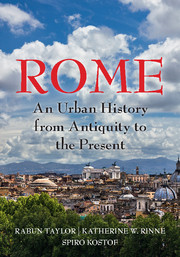Book contents
- Frontmatter
- Dedication
- Epigraph
- Contents
- List of Illustrations
- Acknowledgments
- Map
- INTRODUCTION
- 1 A BEND IN THE RIVER
- 2 A STORYBOOK BEGINNING
- 3 IDEOLOGICAL CROSSFIRE
- 4 BIG MEN ON THE CAMPUS
- 5 RES PUBLICA RESTITUTA
- 6 MEMORIALS IN MOTION: SPECTACLE IN THE CITY
- 7 THE CONCRETE STYLE
- 8 REMAKING ROME'S PUBLIC CORE: I
- 9 REMAKING ROME'S PUBLIC CORE: II
- 10 CRISIS AND CONTINUITY
- 11 RUS IN URBE: A GARDEN CITY
- 12 ADMINISTRATION, INFRASTRUCTURE, AND DISPOSAL OF THE DEAD
- 13 MAPPING, ZONING, AND SEQUESTRATION
- 14 TETRARCHIC AND CONSTANTINIAN ROME
- 15 TROPHIES AND TITULI: CHRISTIAN INFRASTRUCTURE BEFORE CONSTANTINE
- 16 WALLS MAKE CHRISTIANS: FROM FOURTH TO FIFTH CENTURY
- 17 A TALE OF TWO ROMES
- 18 THE ROME OF GOTHS AND BYZANTINES
- 19 CHRISTIAN FOUNDATIONS
- 20 FROM DOMUS LATERANI TO ROMANUM PALATIUM
- 21 THE LEONINE CITY: ST. PETER'S AND THE BORGO
- 22 VIA PAPALIS, THE CHRISTIAN DECUMANUS
- 23 THE URBAN THEATERS OF IMPERIUM AND SPQR
- 24 HOUSING DAILY LIFE
- 25 CHAOS IN THE FORTIFIED CITY
- 26 THE TIBER RIVER
- 27 HUMANIST ROME, ABSOLUTIST ROME (1420–1527)
- 28 PLANNING COUNTER REFORMATION ROME
- 29 PROCESSIONS AND POPULATIONS
- 30 MAGNIFICENT PALACES AND RHETORICAL CHURCHES
- 31 NEOCLASSICAL ROME
- 32 PICTURING ROME
- 33 REVOLUTION AND RISORGIMENTO
- 34 ITALIAN NATIONALISM AND ROMANITÀ
- 35 A CITY TURNED INSIDE OUT
- Glossary of Persons, Places, and Terms
- Works Cited
- Index
24 - HOUSING DAILY LIFE
Published online by Cambridge University Press: 05 July 2016
- Frontmatter
- Dedication
- Epigraph
- Contents
- List of Illustrations
- Acknowledgments
- Map
- INTRODUCTION
- 1 A BEND IN THE RIVER
- 2 A STORYBOOK BEGINNING
- 3 IDEOLOGICAL CROSSFIRE
- 4 BIG MEN ON THE CAMPUS
- 5 RES PUBLICA RESTITUTA
- 6 MEMORIALS IN MOTION: SPECTACLE IN THE CITY
- 7 THE CONCRETE STYLE
- 8 REMAKING ROME'S PUBLIC CORE: I
- 9 REMAKING ROME'S PUBLIC CORE: II
- 10 CRISIS AND CONTINUITY
- 11 RUS IN URBE: A GARDEN CITY
- 12 ADMINISTRATION, INFRASTRUCTURE, AND DISPOSAL OF THE DEAD
- 13 MAPPING, ZONING, AND SEQUESTRATION
- 14 TETRARCHIC AND CONSTANTINIAN ROME
- 15 TROPHIES AND TITULI: CHRISTIAN INFRASTRUCTURE BEFORE CONSTANTINE
- 16 WALLS MAKE CHRISTIANS: FROM FOURTH TO FIFTH CENTURY
- 17 A TALE OF TWO ROMES
- 18 THE ROME OF GOTHS AND BYZANTINES
- 19 CHRISTIAN FOUNDATIONS
- 20 FROM DOMUS LATERANI TO ROMANUM PALATIUM
- 21 THE LEONINE CITY: ST. PETER'S AND THE BORGO
- 22 VIA PAPALIS, THE CHRISTIAN DECUMANUS
- 23 THE URBAN THEATERS OF IMPERIUM AND SPQR
- 24 HOUSING DAILY LIFE
- 25 CHAOS IN THE FORTIFIED CITY
- 26 THE TIBER RIVER
- 27 HUMANIST ROME, ABSOLUTIST ROME (1420–1527)
- 28 PLANNING COUNTER REFORMATION ROME
- 29 PROCESSIONS AND POPULATIONS
- 30 MAGNIFICENT PALACES AND RHETORICAL CHURCHES
- 31 NEOCLASSICAL ROME
- 32 PICTURING ROME
- 33 REVOLUTION AND RISORGIMENTO
- 34 ITALIAN NATIONALISM AND ROMANITÀ
- 35 A CITY TURNED INSIDE OUT
- Glossary of Persons, Places, and Terms
- Works Cited
- Index
Summary
A CITY IS A RESTLESS ORGANISM THAT SHIFTS, ADJUSTS, DECAYS; A THOUSAND small interventions affect its corporate body every day as bits of it shrink and crumble imperceptibly. But this cumulative agitation over several centuries is not necessarily negative. It is simply inevitable change. Thus far we have regarded these changes as they affect medieval Rome's important building complexes and loci of power – the Lateran, the Vatican, the Capitoline, and those institutions and rituals that characterized the Christian center – the titular churches, the diaconiae, the xenodochia, and Via Papalis. But what about the small-scale, fine-grained fabric of the city made up of houses, gardens, industries, and markets? Until recently, medieval everyday life was of little importance to archaeologists, who habitually ignored or discarded its material evidence as they dug down to the ancient city. Fortunately attitudes have changed to such a degree that Rome's medieval archaeology is a growth industry today. Since the 1970s, excavations have revealed the complex reorganization of streets and the transformation of public buildings for residential and industrial uses, especially between the eighth and eleventh centuries.
At the end of antiquity, as the regionary catalogs make clear, there were more than 40,000 apartment units in Rome, some of them five or six stories high. These filled in the cracks of the monumental downtown, pushed up the slopes of the eastern hills, and occupied the southern sector of the fourteenth Augustan region, the Transtiberim. By contrast, most noble estates stood in greenspace, at the crests of the hills, especially the Caelian and Aventine, and we have already noted their physical takeover by Christian institutions.
The transfiguration of the teeming tenement blocks was less sensational than the dissolution of titled property, and thus harder to record. With population decline beginning in the fourth century one must envisage a slow process of partial occupation and then total abandonment, the stripping of usable material, the inevitable collapse and disintegration, and the final burial under rising soil. New structures took over as need and convenience dictated; the urban fabric found its own logic. Once the machinery of public services ground to a slow halt, no attempt was made to control the development of this urban pattern until the thirteenth century, when the office of the magister aedificiorum urbis was revived under the name magister stratarum, superintendent of streets.
- Type
- Chapter
- Information
- RomeAn Urban History from Antiquity to the Present, pp. 222 - 231Publisher: Cambridge University PressPrint publication year: 2016



